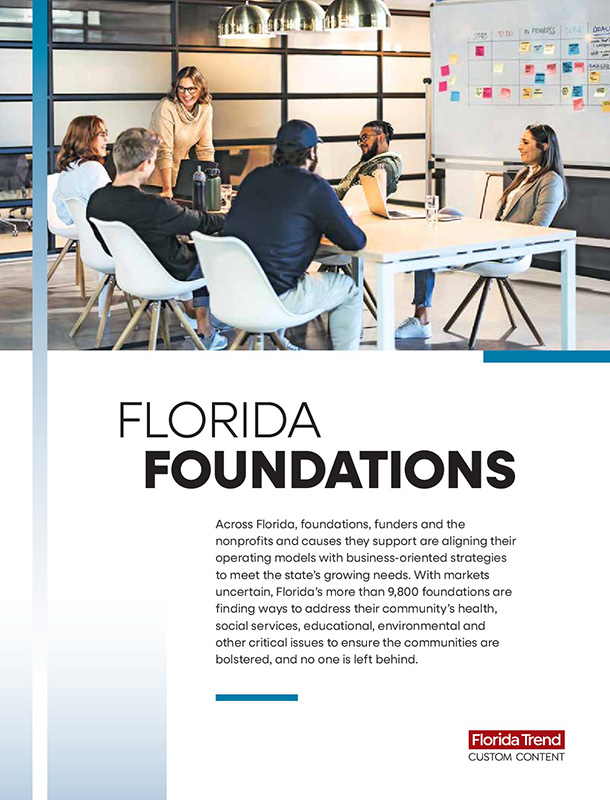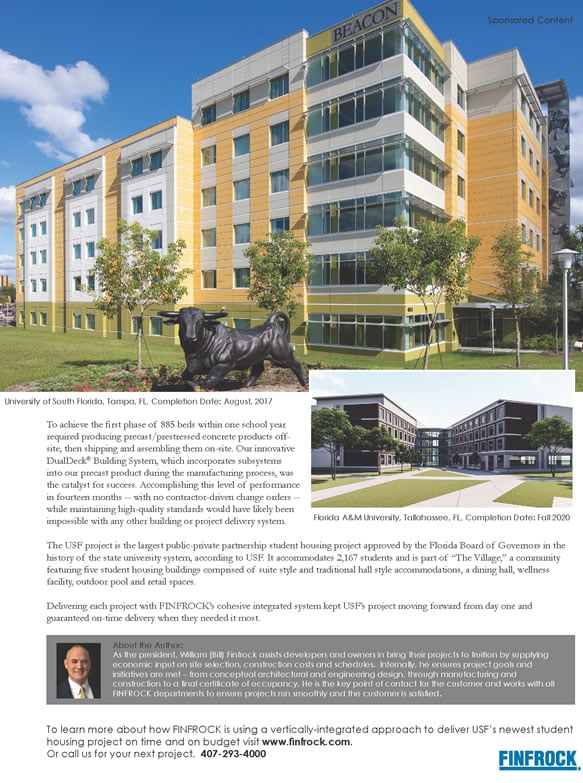From The Jetsons to Back to the Future to The Fifth Element, flying cars have always been the stuff of science fiction, but they might be soaring through Florida’s skies sooner than you think. The state has become a hotbed for flying car companies who view it as an appealing location for their emerging industry.
We’re talking about eVTOLs, electric vertical takeoff and landing vehicles. The nascent beginnings of an air taxi industry using eVTOLs (pronounced EE-vee-tolls) are starting to take shape on the drawing boards of Florida startups, and Florida’s airports are factoring them into their long-term plans. Before too long, small electric aircraft could be whisking passengers between airports and local destinations, zipping above earthbound traffic.
Some eVTOL companies talk of getting off the ground as early as 2025, although the industry consensus seems to be that flying taxis for paying passengers are probably three or four years away, depending on who you ask. In any case, flights will begin once there’s a green light from the federal government, and the future market for eVTOLs in the U.S. could reach $17 billion a year by 2040, according to a Deloitte study of this evolving industry. Meanwhile, state and federal government regulators are starting to grapple with how all of this will actually work in the real world, and the eVTOL industry’s backers are well aware that they’re going to have to win the confidence of consumers on both safety and cost.
All of this is happening now because the technology, influenced by drones, is advancing to the point where the production of eVTOLs is looking more feasible and scalable. Like the popular quadcopter drones that you can now buy at Walmart, eVTOLs have multiple electric propellers and are quieter than planes or helicopters, which is part of their appeal. Advances in electric vehicles such as Teslas have made batteries more powerful too.
Right now, there are literally hundreds of companies around the world trying to develop their own eVTOLs. Everyone wants to be the Henry Ford of the skies. A number of these startups have set up shop in Florida, attracted by the state’s weather, its tourism industry and the congested, traffic-choked roads in its densely populated metropolitan areas. They also like the state’s welcoming regulatory environment.
“The state of Florida is very aggressive. They want to be a first mover. They know they can,” says Philip Brady, the East Coast partnerships and acquisitions manager for Skyports, a British drone service company that’s looking to build “vertiports” for eVTOLs in Florida. “They’ve got everything. They’ve got the weather, they’ve got the economy, they’ve got the tourism, and they’ve got the permitting and regulatory kind of appetite for this — although it needs to be done safely. That’s absolutely critical.”
There have been a number of recent developments with eVTOLs in Florida:
The Airports
Florida’s airports know this is coming. During 2023, the Florida Department of Transportation evaluated how compatible 31 different Florida airports would be with the future use of eVTOLs. And last November, Tampa International Airport hosted Florida’s first public demonstration of an eVTOL in action. A crowd of state and regional leaders watched as a two-seater aircraft developed by German company Volocopter and powered by a dozen small propellers, rose straight up in the air and flew around the airfield. The Federal Aviation Administration set up sensors to monitor the flight. Meanwhile, Volocopter is looking for a Florida investment partner.
“It was like watching the Wright Brothers — totally new technology that no passengers have flown on yet,” recalls airport CEO Joe Lopano. He foresees a near future where passengers will be able to take an air taxi from the airport to nearby cities like St. Petersburg, Bradenton or Lakeland. “It’s almost like an Uber in the air.”
Although air taxis will likely start out as a luxury, the industry’s backers predict that they’ll become more affordable to the general public over time as they become more prevalent. Last summer, the Tampa airport mapped out a potential landing and departure site for flying taxi services in an update of its master plan. “We know it’s coming,” Lopano says.
Orlando International Airport is also drawing up conceptual plans for infrastructure for eVTOLs. Renderings show how a vertiport could be located near the airport’s Brightline passenger train station, and how there’s room for new hangars and possibly a research and development center on the East Airfield portion of the airport’s huge property.
“By putting a vertiport right next to the train station, we get the best of both worlds. That eVTOL operator can tap into Brightline customers that come here, or SunRail (commuter rail service) customers once it’s extended to the airport, as well as the airport customers,” says Kevin Thibault, CEO of the Greater Orlando Aviation Authority and former secretary of FDOT. “I think this state has the ability to really become the leader in the country in working with this industry.”
Miami Air Taxis
Naturally, there’s an air taxi system envisioned for South Florida too. In November, Miami-based Global Crossing Airlines Group announced it was launching a new venture: UrbanX Air, which intends to operate electric air taxi flights throughout the South Florida region, initially centered around Miami International Airport. The idea is that flights could begin as early as 2026 or 2027, pending FAA approval.
UrbanX has signed a letter of intent to purchase 200 eVTOLs from Eve Air Mobility, a company headquartered a few hour’s drive north in Melbourne. United Airlines has also invested $15 million in Eve and is contracted to buy at least 200 of their aircraft.
A subsidiary of the Brazilian aerospace manufacturer Embraer, Eve is working on multiple prototypes for electric aircraft. It’s developing an air taxi with a four-passenger cabin, which would become a six-passenger cabin once the pilot seat is removed and the craft is piloted remotely, like a drone, says David Rottblatt, Eve’s vice president of sales and government relations. The current version would fly 60 miles on a single charge.
“Full-scale production will begin after the aircraft is certified by the FAA,” Rottblatt says. “We’ve signed letters of intent for up to 2,850 aircraft. That’s a combination of firm orders plus options. It’s the largest backlog in the industry.”
The Roadster
In Pompano Beach, a startup called Doroni has an entirely different business model. It’s developing a smaller, lighter, two-seater flying roadster meant for personal use. Founder and CEO Doron Merdinger was struck by the idea when he was stuck in a traffic jam and saw a kid playing with a drone. He also was inspired by the flying cars he recalled from Chitty Chitty Bang Bang, The Jetsons and Back to the Future.
Merdinger is an Israeli-American who previously launched a successful jewelry design business and has since moved into eVTOLs. He envisions a flying car that owners would drive themselves, using a joystick. They’d need a Light Sport Aircraft pilot certificate, a license that allows recreational pilots to operate small, two-seater aircraft. “I look at it as a three-dimensional elevator,” he says. It would fly at an altitude of a few hundred feet. The vehicle would be self-stabilizing and would use semi-autonomous navigation the way a drone does and would utilize “geofencing” software preventing it from being flown into dangerous areas like airports or over sensitive government buildings.
Doroni spent the second half of 2023 testing out a prototype, with pilots flying it around inside a big warehouse in Pompano Beach. Called the H1, the aircraft fits in a two-car garage. In November, the vehicle received a Special Airworthiness Certification from the Federal Aviation Administration, allowing Doroni to begin manned outdoor test flights this year.
The H1 will cost $300,000-$400,000, Merdinger predicts. He says they have more than 400 pre-orders with deposits. Doroni aims to manufacture at least a dozen vehicles by the end of 2025.
The Jet
Then there’s a third business model — regional flights between cities using eVTOLs. A German company named Lilium, whose American employees are mostly based in Florida, is developing a craft it calls the Lilium Jet. It would go 110 miles before it needs recharging, so Lilium envisions it being used for longer flights, says Matthew Broffman, Lilium’s director of partnerships in the U.S.
For vertical takeoff and landing sites, they’re looking at making deals to secure locations on the tops of parking garages. Most eVTOLs take off and land straight up and down, eliminating the need for traditional aircraft runways.
The current version of the Lilium Jet is powered by 30 tilt-rotor engines. It seats four to six passengers, depending on how the interior is configured. It’s less complex than traditional planes or helicopters, with fewer moving parts in its engines. Lilium is seeking to connect to the private jet market in the U.S. and Dubai, and it says it’s getting closer to getting its aircraft certified for public use by the FAA and the European Union Aviation Safety Agency.
“Florida presents a great commercial opportunity in a variety of ways. Florida has a lot of cities that are fairly disconnected, and our transportation system has just not kept up with the growing demand and population that’s moving to Florida each and every day,” Broffman says. “When it comes to working with governments, we’ve seen a real willingness from the state level and the local level to be part of the conversation to help figure out the right way to make sure we integrate this properly.”












